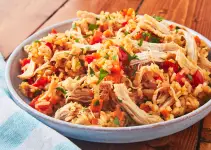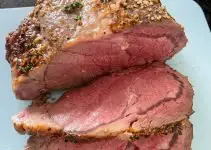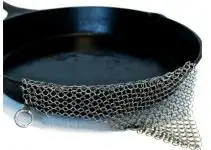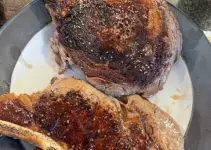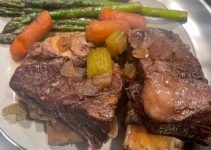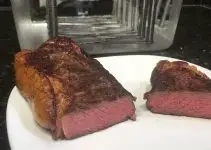The question “can you overcook with sous vide” is a bit more nuanced than just a simple “yes” or “no”. Sous vide (In French “under vacuum”) cooking has become popular for fine chefs and home cooks. Food is sealed in a plastic bag, submerged in a pre-heated water bath, and is cooked slowly and gently, thanks to a water circulator that controls the temperature.
Cooking using the sous vide method holds food at a controlled temperature for a certain amount of time, so it can’t really be overcooked as far as level of doneness is concerned. However, if the food is held at temperature for too long, the proteins will continue to break down, and the texture can become compromised. Why does this happen?
The science behind a tender steak
In a piece of steak, there is actually only about 20% protein; the remainder is fat, water, and collagen (connective tissues that hold the muscle fibers in place).1
Proteins (actin and myosin) are the muscle fibers of the meat, and heating the proteins begins to start to break them down, which starts at about 100 degrees Fahrenheit. If temperature continues to rise, the fibers will continue to shrink and begin to release water, leaving you with a tough, dry piece of meat.
This is why most temperatures for sous vide steak or other proteins are below 140 degrees Fahrenheit; it ensures that the food is heated through, the proteins are broken down (denatured), but without being overheated, risking release of the precious juice in the food.
Protein vs. collagen
Another benefit of sous vide cooking is that it helps to contract and denature collagen at about 130 degrees Fahrenheit.1 Collagen is what gives meat its tough texture, so breaking down collagen means you’ll have a much more tender piece of meat. This is why stewed meat is often cooked low and slow, and why it takes so long to produce a tender, juice pork shoulder or roast beef.
However, a lot of heat is lost during the cooking process using traditional methods like oven roasting or slow-cooking; a water bath is ten times more efficient at heat transfer, and using a high-quality circulator means that you’ll likely have a perfect piece of meat every time. Check out the article on immersion circulators to find a sous vide machine that’s perfect for you.
Why are cook times so vague?
So what happens if you leave a piece of meat in a sous vide bath for longer than the recommended time? It depends on the time. Check out this informative article for cook times on everything from potatoes to pork! Most sous vide recipes are generous, giving a wide time frame for doneness; for example, most recipes give a range of about 1-4 hours for a medium rare steak, cooked to 130 degrees. The water bath will be heated to precisely this temperature, meaning that the steak’s internal temperature will not continue to rise once it’s reached 130 degrees.
However, the longer the meat sits in the water bath, the longer the proteins and collagen have to denature and break down. This can lead to a stringy or even mushy piece of meat, which may be unpalatable to some, and especially disappointing if you’ve invested in a high-quality cut of meat. An extended cook time, like the 24-hour steak recipes, are best for larger, tougher cuts of meat that usually require long, low slow cook times, like a roast or even prime rib.
The bottom line is that sous vide cooking is a great way to prepare a lot of different types of food. It provides a gentle, consistent heating method that ensures your food stays juicy and perfectly cooked. However, longer doesn’t always mean better, and the longer a food is held, the longer it will continue to break down. This means that you could end up with a stringy, mushy piece of protein (or vegetable) instead of a perfectly cooked meal.
Looking for recipes? Check out this delicious recipe for a perfectly tender and juicy beef roast.
Contributor:
This article was written by Stephanie Searor, MS RD LDN
Reference:
- Hughes J. Science meets food. The science behind sous vide cooking- and how to explain it to your friends. http://sciencemeetsfood.org/science-behind-sous-vide-cooking-explain-friends/. Updated 3 August 2019. Accessed December 22, 2019.

